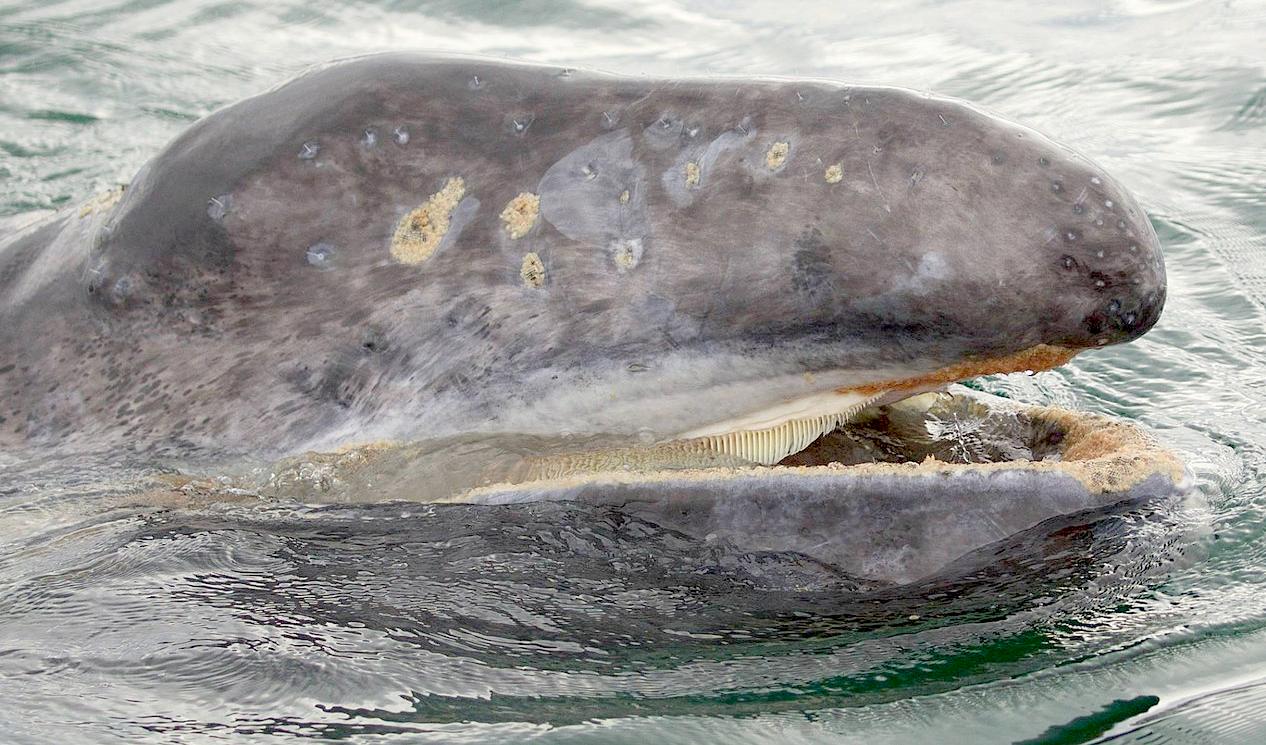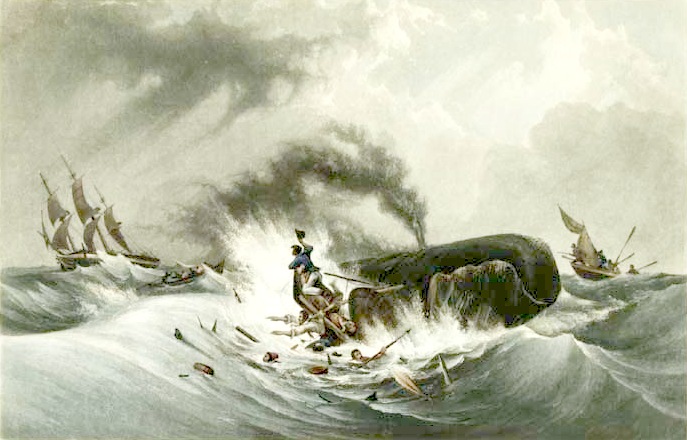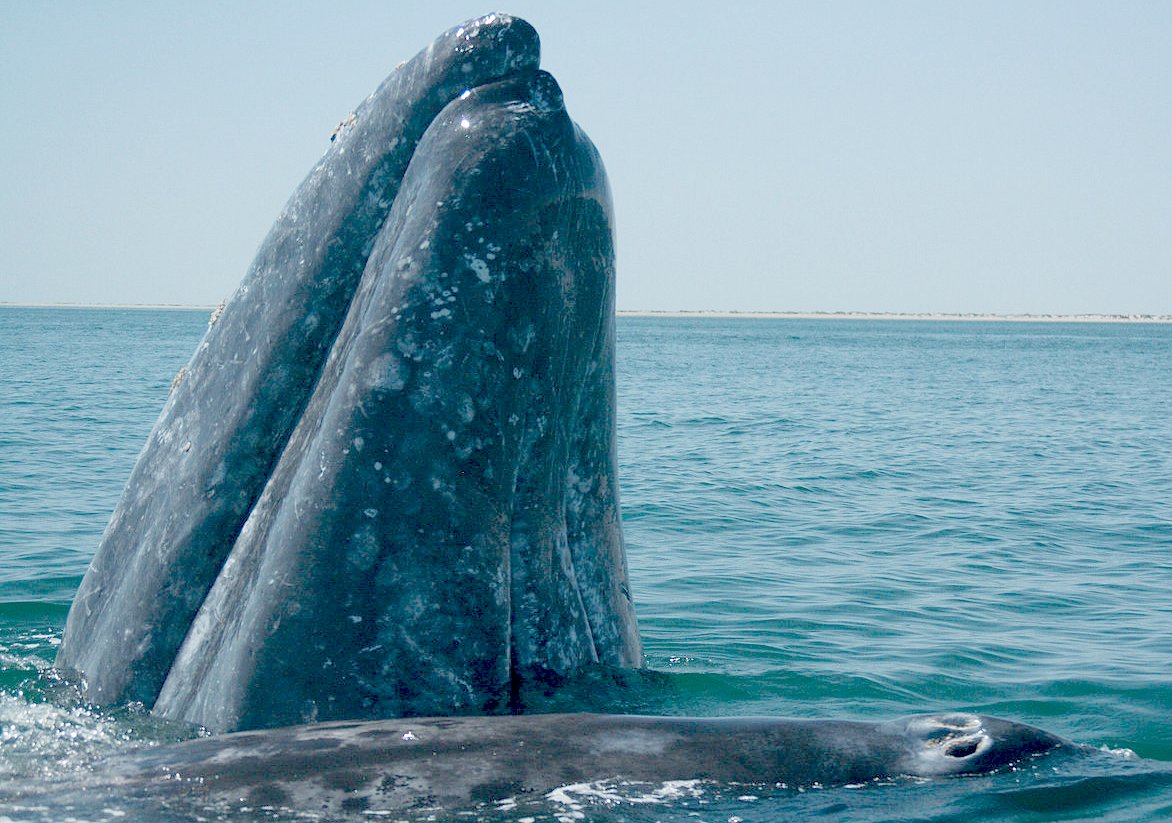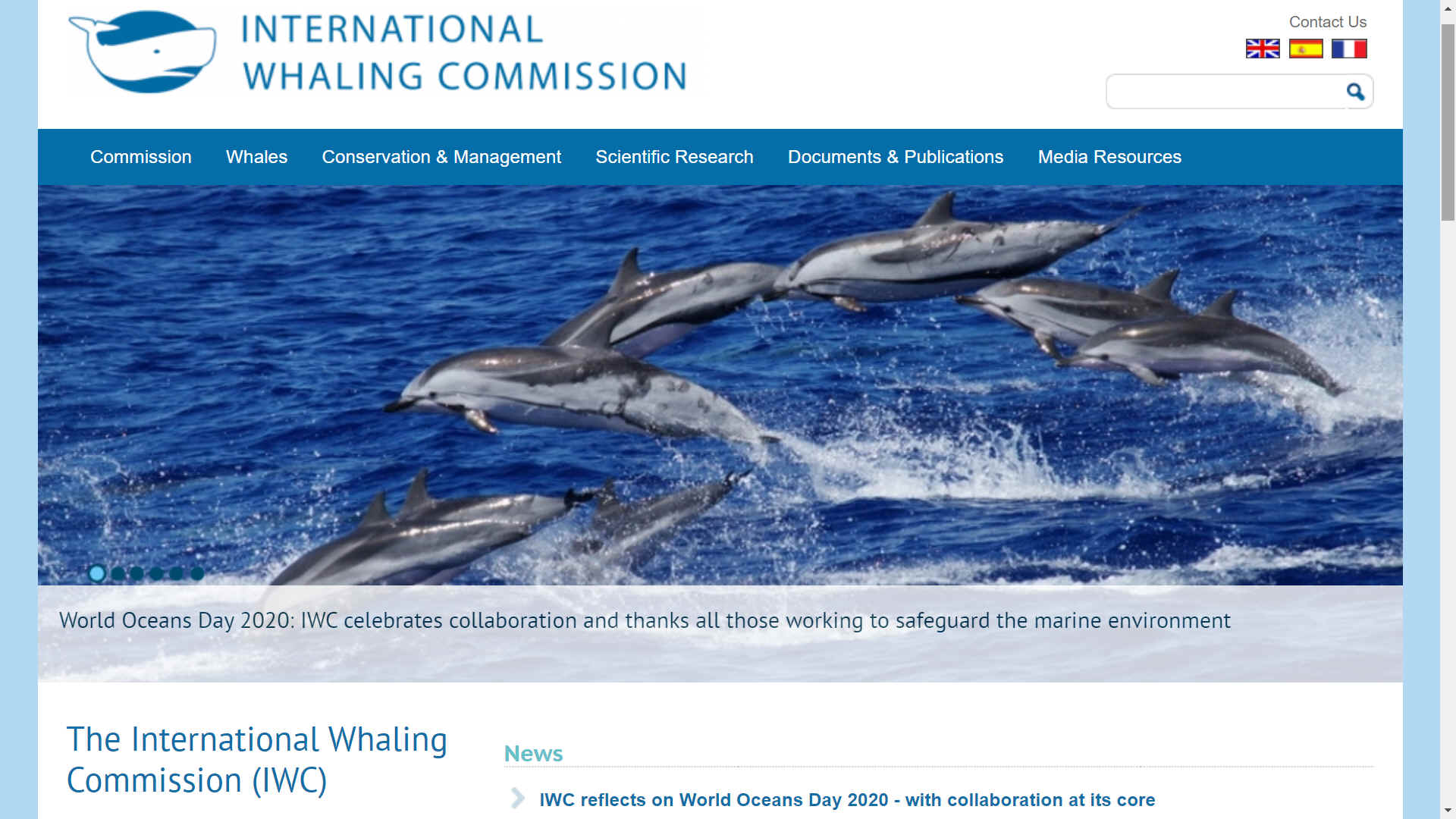
A gray whale calf showing
the baleen plates.
The gray whale
(Eschrichtius robustus), also known as the grey whale, gray back whale, Pacific
gray
whale, or California gray whale, is a baleen whale that migrates between feeding and breeding grounds yearly. It reaches a length of 14.9 meters (49 ft), a weight of up to 41 tonnes (90,000 lb) and lives between 55 and 70 years, although one female was estimated to be 75-80 years of age. The common name of the whale comes from the gray patches and white mottling on its dark skin. Gray whales were once called devil fish because of their fighting behavior when hunted. The gray whale is the sole living species in the genus
Eschrichtius, which in turn is the sole living genus in the family
Eschrichtiidae. This mammal is descended from filter-feeding whales that appeared at the beginning of the Oligocene, over 30 million years ago.
The gray whale is distributed in an eastern North Pacific (North American), and an endangered western North
Pacific (Asian), population. North Atlantic populations were extirpated (perhaps by whaling) on the European coast before AD 500, and on the American coast around the late 17th to early 18th centuries. Even so, on May 8, 2010, a sighting of a gray whale was confirmed off the coast of Israel in the Mediterranean Sea, leading some scientists to think they might be repopulating old breeding grounds that have not been visited for centuries. In May and June 2013, a gray whale was sighted off the coast of Namibia – the first confirmed in the Southern Hemisphere. The round-trip journey of one gray whale has set a new record for the longest mammal migration, covering a distance of more than 22,000 kilometres across the Pacific Ocean. Her migration has shown new insight into how endangered species are making drastic changes in their life style.

WHALING
EASTERN POPULATION
Humans and killer whales (orcas) are the adult gray whale's only predators, although orcas are the more prominent predator. Aboriginal hunters, including those on Vancouver Island and the Makah in Washington, have hunted gray whales.
Commercial whaling by Europeans of the species in the North Pacific began in the winter of 1845–46, when two United States ships, the Hibernia and the United States, under Captains Smith and Stevens, caught 32 in Magdalena Bay. More ships followed in the two following winters, after which gray whaling in the bay was nearly abandoned because "of the inferior quality and low price of the dark-colored gray whale oil, the low quality and quantity of whalebone from the gray, and the dangers of lagoon whaling."
Gray whaling in Magdalena Bay was revived in the winter of 1855–56 by several vessels, mainly from San Francisco, including the ship Leonore, under Captain Charles Melville Scammon. This was the first of 11 winters from 1855 through 1865 known as the "bonanza period", during which gray whaling along the coast of Baja California reached its peak. Not only were the whales taken in Magdalena Bay, but also by ships anchored along the coast from San Diego south to Cabo San Lucas and from whaling stations from Crescent City in northern California south to San Ignacio Lagoon. During the same period, vessels targeting right and bowhead whales in the Gulf of Alaska, Sea of Okhotsk, and the Western Arctic would take the odd gray whale if neither of the more desirable two species were in sight.
In December 1857, Charles Scammon, in the brig Boston, along with his schooner-tender Marin, entered Laguna Ojo de Liebre (Jack-Rabbit Spring Lagoon) or later known as Scammon's Lagoon (by 1860) and found one of the gray's last refuges. He caught 20 whales. He returned the following winter (1858–59) with the bark Ocean Bird and schooner tenders A.M. Simpson and Kate. In three months, he caught 47 cows, yielding 1,700 barrels (270 m3) of
oil. In the winter of 1859–60, Scammon, again in the bark Ocean Bird, along with several other vessels, entered San Ignacio Lagoon to the south where he discovered the last breeding lagoon. Within only a couple of seasons, the lagoon was nearly devoid of whales.
Between 1846 and 1874, an estimated 8,000 gray whales were killed by American and European whalemen, with over half having been killed in the Magdalena Bay complex (Estero Santo Domingo, Magdalena Bay itself, and Almejas Bay) and by shore whalemen in California and Baja California.
A second, shorter, and less intensive hunt occurred for gray whales in the eastern North Pacific. Only a few were caught from two whaling stations on the coast of California from 1919 to 1926, and a single station in Washington (1911–21) accounted for the capture of another. For the entire west coast of North America for the years 1919 to 1929, 234 gray whales were caught. Only a dozen or so were taken by British Columbian stations, nearly all of them in 1953 at Coal Harbour. A whaling station in Richmond, California, caught 311 gray whales for "scientific purposes" between 1964 and 1969. From 1961 to 1972, the Soviet Union caught 138 gray whales (they originally reported not having taken any). The only other significant catch was made in two seasons by the steam-schooner California off Malibu, California. In the winters of 1934–35 and 1935–36, the California anchored off Point Dume in Paradise Cove, processing gray whales. In 1936, gray whales became protected in the United States.
WESTERN POPULATION
The Japanese began to catch gray whales beginning in the 1570s. At Kawajiri, Nagato, 169 gray whales were caught between 1698 and 1889. At Tsuro, Shikoku, 201 were taken between 1849 and 1896. Several hundred more were probably caught by American and European whalemen in the Sea of Okhotsk from the 1840s to the early 20th century. Whalemen caught 44 with nets in Japan during the 1890s. The real damage was done between 1911 and 1933, when Japanese whalemen killed 1,449 after Japanese companies established several whaling stations on Korean Peninsula and on Chinese coast such as near the Daya bay and on Hainan Island. By 1934, the western gray whale was near extinction. From 1891 to 1966, an estimated 1,800–2,000 gray whales were caught, with peak catches of between 100 and 200 annually occurring in the 1910s.
As of 2001, the Californian gray whale population had grown to about 26,000. As of 2016, the population of western Pacific (seas near Korea, Japan, and Kamchatka) gray whales was an estimated 200.
NORTH ATLANTIC
The North Atlantic population may have been hunted to extinction in the 18th century. Circumstantial evidence indicates whaling could have contributed to this population's decline, as the increase in whaling activity in the 17th and 18th centuries coincided with the population's disappearance. A. B. Van Deinse points out the "scrag whale", described by P. Dudley in 1725, as one target of early New England whalers, was almost certainly the gray whale. In his 1835 history of Nantucket Island, Obed Macy wrote that in the early pre-1672 colony, a whale of the kind called "scragg" entered the harbor and was pursued and killed by the settlers. Gray whales (Icelandic sandlægja) were described in Iceland in the early 17th century. Formations of industrial whaling among the
Mediterranean
basin(s) have been considered to be feasible as well.

CONSERVATION
Gray whales have been granted protection from commercial hunting by the International Whaling Commission (IWC) since 1949, and are no longer hunted on a large scale.
Limited hunting of gray whales has continued since that time, however, primarily in the Chukotka region of northeastern Russia, where large numbers of gray whales spend the summer months. This hunt has been allowed under an "aboriginal/subsistence whaling" exception to the commercial-hunting ban. Anti-whaling groups have protested the hunt, saying the meat from the whales is not for traditional native consumption, but is used instead to feed animals in government-run fur farms; they cite annual catch numbers that rose dramatically during the 1940s, at the time when state-run fur farms were being established in the region. Although the Soviet government denied these charges as recently as 1987, in recent years the Russian government has acknowledged the practice. The Russian IWC delegation has said that the hunt is justified under the aboriginal/subsistence exemption, since the fur farms provide a necessary economic base for the region's native population.
Currently, the annual quota for the gray whale catch in the region is 140 per year. Pursuant to an agreement between the United States and Russia, the Makah tribe of Washington claimed four whales from the IWC quota established at the 1997 meeting. With the exception of a single gray whale killed in 1999, the Makah people have been prevented from hunting by a series of legal challenges, culminating in a United States federal appeals court decision in December 2002 that required the National Marine Fisheries Service to prepare an Environmental Impact Statement.
On September 8, 2007, five members of the Makah tribe shot a gray whale using high-powered rifles in spite of the decision. The whale died within 12 hours, sinking while heading out to sea.
As of 2008, the IUCN regards the gray whale as being of least concern from a conservation perspective. However, the specific subpopulation in the northwest Pacific is regarded as being critically endangered. The northwest Pacific population is also listed as endangered by the U.S. government’s National Marine Fisheries Service under the U.S. Endangered Species Act. The IWC Bowhead, Right and Gray Whale subcommittee in 2011 reiterated the conservation risk to western gray whales is large because of the small size of the population and the potential anthropogenic impacts.
Gray whale migrations off of the Pacific Coast were observed, initially, by Marineland of the Pacific in Palos Verdes, California. The Gray Whale Census, an official gray whale migration census that has been recording data on the migration of the Pacific gray whale has been keeping track of the population of the Pacific gray whale since 1985. This census is the longest running census of the Pacific gray whale. Census keepers volunteer from December 1 through May, from sun up to sun down, seven days a week, keeping track of the amount of gray whales migrating through the area off of Los Angeles. Information from this census is listed through the American Cetacean Society of Los Angeles (ACSLA).
South Korea and China list gray whales as protected species of high concern. In South Korea, the Gray Whale Migration Site was registered as the 126th national monument in 1962, although illegal hunts have taken place thereafter, and there have been no recent sightings of the species in Korean waters.
THREATS
According to the Government of Canada's Management Plan for gray whales, threats to the eastern North Pacific population of gray whales include: increased human activities in their breeding lagoons in Mexico, climate change, acute noise, toxic spills, aboriginal whaling, entanglement with fishing gear, boat collisions, and possible impacts from fossil fuel exploration and extraction.
Western gray whales are facing, the large-scale offshore oil and gas development programs near their summer feeding ground, as well as fatal net entrapments off Japan during migration, which pose significant threats to the future survival of the population. The substantial nearshore industrialization and shipping congestion throughout the migratory corridors of the western gray whale population represent potential threats by increasing the likelihood of exposure to ship strikes, chemical pollution, and general disturbance.
Offshore gas and oil development in the Okhotsk Sea within 20 km (12 mi) of the primary feeding ground off northeast Sakhalin Island is of particular concern. Activities related to oil and gas exploration, including geophysical seismic surveying, pipelaying and drilling operations, increased vessel traffic, and oil spills, all pose potential threats to western gray whales. Disturbance from underwater industrial noise may displace whales from critical feeding habitat. Physical habitat damage from drilling and dredging operations, combined with possible impacts of oil and chemical spills on benthic prey communities also warrants concern. The western gray whale population is considered to be endangered according to IUCN standards.
Along Japanese coasts, four females including a cow-calf pair were trapped and killed in nets in the 2000s. There had been a record of dead whale thought to be harpooned by dolphin-hunters found on Hokkaido in the 1990s. Meats for sale were also discovered in Japanese markets as well.
2019 has had a record number of gray whale standings and deaths, with their being 122 standings in United States waters and 214 in Canadian waters. The cause of death in some specimens appears to be related to poor nutritional condition. It is hypothesized that some of these strandings are related to changes in prey abundance or quality in the Arctic feeding grounds, resulting in poor feeding. Some scientists suggest that the lack of sea ice has been preventing the fertilization of amphipods, a main source of food for gray whales, so that they have been hunting krill instead, which is far less nutritious. More research needs to be conducted to understand this issue.
A recent study provides some evidence that solar activity is correlated to gray whale strandings. When there was a high prevalence of sunspots, gray whales were five times more likely to strand. A possible explanation for this phenomenon is that solar storms release a large amount of electromagnetic radiation, which disrupts earth’s magnetic field and/or the whale’s ability to analyze it. This may apply to the other species of cetaceans, such as sperm whales. However, there is not enough evidence to suggest that whales navigate through the use of magnetoreception (an organisms’ ability to sense a magnetic field).
Killer whales are "a prime predator of gray whale calves." Typically three to four killer whales ram a calf from beneath in order to separate it from its mother, who defends it. Humpback whales have been observed defending gray whale calves from orcas. Killer whales will often arrive in Monterey Bay to intercept gray whales during their northbound migration, targeting females migrating with newborn calves. They will separate the calf from the mother and hold the calf under water to drown it. It is roughly estimated that 33% of the gray whales born in a given year might be killed by predation.
Hunting
gray whales is forbidden by
international
law.

IWC is a voluntary
international organization and is not backed up by treaty, therefore,
the IWC has substantial practical limitations on its authority. First,
any member countries are free to simply leave the organization and
declare themselves not bound by it if they so wish. Second, any member
state may opt out of any specific IWC regulation by lodging a formal
objection to it within 90 days of the regulation coming into force (such
provisions are common in international agreements, on the logic that it
is preferable to have parties remain within the agreements than opt out
altogether). Third, the IWC has no ability to enforce any of its
decisions through penalty imposition.
Please use our
A-Z INDEX to
navigate this site



